|
|
|
The Hut
(An article written for Solar Survival Architechture- 09/03
We never imagined the
time and energy that was involved in building our own hut. Yet,
after 9 days of our first workshop hosted on our 63-acre farm in the
Allegheny mountains of West Virginia, our reflection on the synergistic
effect of all the variable involved amazed us as we joyously climbed the
black-treaded walls which would, far sooner than we realized, become
our home.
We expected to accomplish little when we purchased our off-the-grid property in 2002, 3 1/2 hours from our current residence in Virginia. Over the course of the first year, we renovated the converted bus left by the owner, installed an electrical hookup and planted 200 windbreak trees. When the following spring rolled around, we decided to spend our vacation hosting a 9-day hut building workshop. Armed with skills gathered from a month long internship I had attended at Solar Survival the previous summer and years of reading and research, we began immersing ourselves in the details. We spent approximately three months advertising for the workshop, watching and rewatching SSA's hut video, compiling lists, calling vendors and gathering materials from the dump, building supply stores, tire salvage yards and finally and most frustrating Home Depot. A word or caution: you must pay for your "will call" list before they will pick it for you and call 4 hours ahead to make sure it is completed.
We spent the weekend prior to the workshop overseeing the excavation and preparing the land and bus for the 5-6 volunteers we expected.
The following weekend, we arrived a day early to finish off the excavation and began pounding our first tires. Over the next two days volunteers arrived and the huge tire pile (approximately 275 235/75/R15) dwindled. We took a break for several important steps along the way. The first included forming a gravel base and installing a French drain around the floor and exterior perimeter of the tire wall. The second consisted of creating a concrete foundation for the 2" x 12" door buck, which was subsequently secured and braced the following day. All the volunteers, from Texas, Maryland, Virginia and DC worked hard, absorbed the soreness and exhaustion and offered great company and conversation. We are truly indebted for their contributions! The day before the first set of volunteers was to leave, we reached a rewarding point. All possible tires, prior to making half blocks along the door buck were fully pounded and leveled. More day volunteers along will family members made the trek and we began the wing walls.
By the time it was over, we were exhausted and the beautiful clear weather abated to sudden thundershowers making the soil too muddy to pound. We took a couple of needed days for vacation type stuff and returned to the real world. Our experience is one we will never forget. There was a sense of community contribution, similar to the Amish barn-raisings, and although most of the volunteers were strangers to us and each other, that spirit carried throughout the course of the workshop. We have returned each weekend since then and have accomplished much.
We are slowly starting to realize the big picture of building one's own home. Aside from the obvious reasons of the high quality, long-lasting end product, saving money and using a worldwide waste product, a project of this kind is just plain 'ol good for the soul. They say when you build your own home, its never done. At this point, we wouldnt mind.

© 2003-04
|
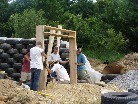
all hands on
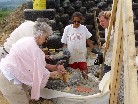
a special 200 year old brick
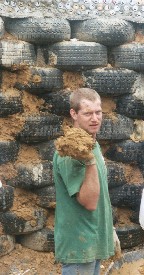
packing out
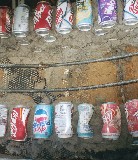
the can wall
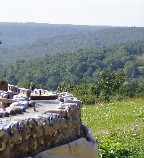
the bond beam

taking a break
|



